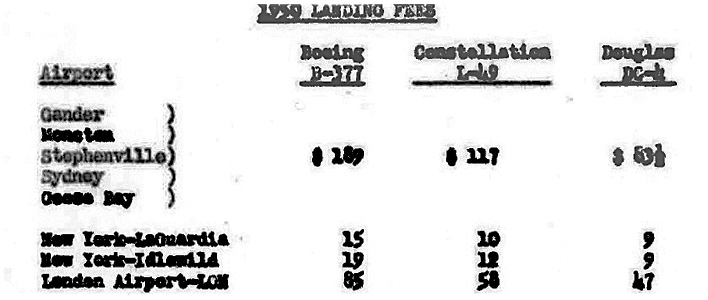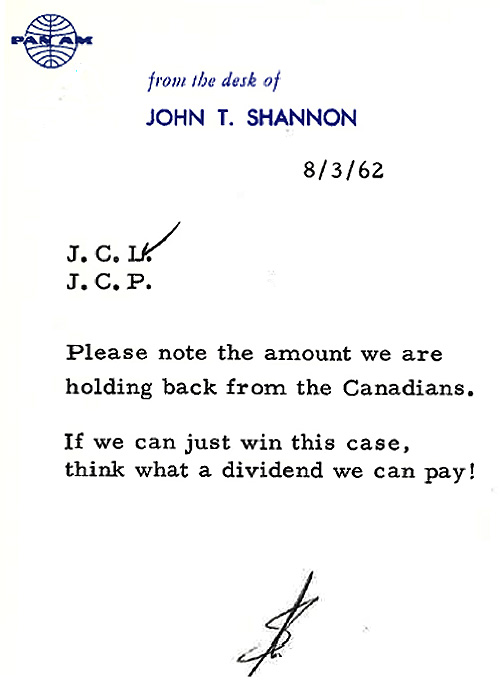
By Robert G. Pelley, 2017-12-11. http://bobsganderhistory.com Mr. Pelley is a long-time military and aviation enthusiast who grew up in Gander, Newfoundland – the “Crossroads of the World.” He served as officer in two of Canada’s finest regiments: The Princess Patricia’s Canadian Light Infantry and also with the Royal 22e Régiment, the famous French-speaking “Vandoos.” We are indebted to him for the use of this material. Used by permission with photos provided by Mr. Pelley. Link to Pan Am Ops in Gander Part 2
Pan Am Ops in Gander Part 1 - 1940s & 1950s
The local history of the different airlines that used Gander Airport has pretty much been lost. How were their operations carried out? How many Newfoundlanders were found in their ranks? What problems did they run into? What types of aircraft did they use? What contribution did they make to Gander?
While much of this information is now missing, this article hopes to throw some light on the operations in Gander of Pan American World Airways (known to many as PAA or more often in everyday conversation as Pan Am).
Botwood & Pan Am’s First North Atlantic Aircraft: Sikorsky S-42s
The first contact of Pan Am with Nfld was not with Gander but with the inland bay of Botwood, near the mouth of the Exploits River.
On 05 July 1937 flying boat survey flights across the North Atlantic began. A Pan Am Clipper III, a Sikorsky S-42, from Port Washington, via Shediac, NB, landed at Botwood and headed next day for Foynes in Ireland. On the same day, a Short Empire C-Class flying boat, the Caledonia, left Foynes for Botwood, and landed July 6, 1937, reaching Montreal on July 8 and New York on July 9.
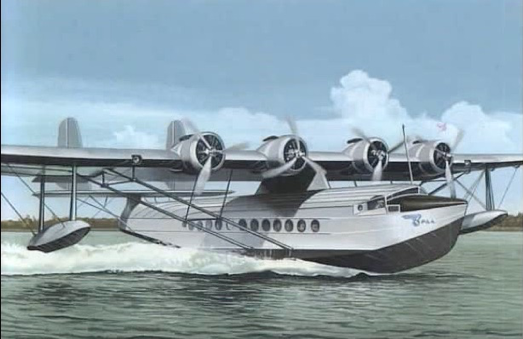 Pan Am S-42 Clipper
Pan Am S-42 Clipper
These aircraft, as were those operated by Britain's equivalent Imperial Airways, did not fly the North Atlantic during the winter. The Second World War, which started on 01 September 1939, put an end to any regular scheduled activity.
Land Planes at Gander: Boeing 307 Stratoliner
In any case, thought was turning towards land-based planes in the hope that their performance would eventually permit trans-continental and trans-Atlantic flight. To this end, in 1940 Pan Am and Trans World Airways (TWA) began using the Boeing 307 Stratoliner. This aircraft, based on the same basic airframe as the famous B-17 Flying Fortress, was the first pressurized airliner in service and the first with a flight engineer in the crew. The Boeing 307's civilian use was short-lived, being pressed into military service when the US entered World War II. Five of these, manned by civilian crews, flew from Gander out over the north Atlantic. However, the US Air Transport Command had divided the world made into two basic regions, with Pan Am being given more or less the Pacific and Latin America. The Boeing 307s that crossed the Atlantic were therefore manned by TWA crews, with none from Pan Am.
A Forlorn Hope for PostWar Botwood
At war's end, while the possibility of land-based civilian traffic became obvious, the continued use of Botwood was surprisingly not excluded. This was based notably on the idea that sportsman would interested in flying to Central Nfld. It was funny just the same that, on 02 July 1945, two Pan Am managers in the US exchanged the information below:
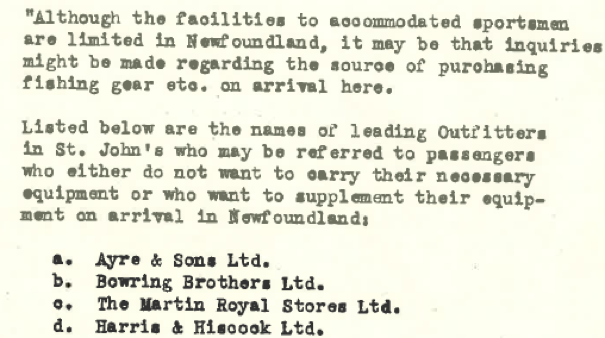
These chaps obviously hadn't looked at a map to see the distances and the difficulty of getting to St John's from Botwood, roughly 450 kms on the "Newfy Bullet" as it was affectionately known, a very slow and sometimes cantankerous train – not much good if you needed to buy a few rounds of 30-06!
These same two officials exchanged information on July 18 to the effect that:
"The sudden upswing of bookings to Shediac and Botwood that has occurred since July 1st makes us believe that the summer season in Newfoundland is just getting underway."
A further memo on the same day says:
"You already know of the report from the District Traffic Manager in Botwood that there is a colony of about 70,000 Newfoundlanders in Boston. It appears that Northeast Airlines, by connection with TCA at Moncton, is booking considerable business from the Boston area, some of which is off-loaded at Moncton and travelling by Clipper to Botwood. These off-loadees indicate that Bostonians would be glad to come to New York to take the Clipper if the service were generally known - especially, for such destinations as Gander Lake. Corner Brook, Grand Falls and Bishops Falls in Western Newfoundland (sic). The Advertising Manager and J. Walter Thompson Co. are currently finishing several small advertisements approved by Mr. Chenea (and covered by the System Advertising Budget). These will appear in the next 2 weeks in Boston papers, carrying the wording you requested."
It is not known to what extent this was a paying proposition, though Leonard Outerbridge, a prominent merchant from St John's who later became Lieutenant-Governor, played a marketing role on the Nfld side. If there was any interest, any business done through Botwood could of course eventually be done just as easily though Gander.
Gander on Pan Am’s Radar
Pan Am showed its developing interest in Gander well before the end of the war. As early as October 1944, Pan Am officials were discussing topics as mundane as taxes that passengers might have to pay.
"Referring to our letters of October 11 and October 17 on refund of taxes, we now plan to include Newfoundland in the Passenger Tax Tariff. As you know Newfoundland is not a part of Canada and the Canadian Tax Laws are not applicable there."
By May of 1945 there seems to already have a certain amount of communications between Pan Am and HAL Pattison, the Director of Civilian Aviation in Gander, including a missed meeting of Mr. Pattison with Pan Am officials at LaGuardia.
However, the role of civil aviation in Gander was still not clear as summer 1945 drew to a close, as can be seen in this extract of 21 August between the Atlantic area Chief Pilot and Pan Am in Washington:
"Work on route and airport information has developed as follows: The designation of a civil airport in Newfoundland has not yet been made. An Interdepartmental committee, from the CAB, Amy, Navy, and State Department, has been working on the disposal of the Destroyer Bases in Canada, Newfoundland, and Bermuda. Vice President Torrill Drinkwater of American Airlines, Peter Redpatch of TWA, and myself have been working with this group. Gander versus Stephenville has been discussed, but a final recommendation cannot be made by our group until American Airlines decides what they want."
By 29 September 1945, one aspect had been cleared up, namely the initial right to fly and test the route. On that date the manager Atlantic Division received a notice that clearances had been signed by the American Consul in Nfld and the ambassadors of Eire and England for four test flights. Approval for regular flights appears to have given by 01 December.
Airlines Carriers & the Gander Committee
The right to fly over or through a country is one thing but what passengers (or cargo) can be carried is another. This brings us the basic "Five Freedoms", established at international aviation conference attended by fifty-two nations in Chicago in 1944 (although several other variations were later added). The starting point was the declaration that "no scheduled international air service may be operated over or into the territory of a contracting state, except with the special permission or other authorization of that state, and in accordance with such permission or authorization", which has ever since put aviation negotiations in the hands of national governments. The first five freedoms describe the rights of an aircraft registered in one country:
1. to over-fly another country
2. to make a technical landing in another country,
3. to set down passengers from its own country in another country
4. to pick up passengers in another country and fly them to its own country
5. to pick up passengers in another country and fly them on to a third country
While is hard to understand exactly how they were involved, on 04 December 45, SM Connell, Brigadier-General commanding the US Nfld Base Command, informed Pan Am in LaGuardia that he was happy to learn that the Nfld Government had approved 3rd and 4th rights for American Airlines and had forwarded same to the British government for approval. Approval for Pan Am was expected to follow.
This subject came up later in terms of practical application, as can be seen from the minute 521 below of 75th meeting of the "Gander Airlines committee" of 27 February 1952.
"The Chairman asked Mr. Baldwin for what purpose the information was being requested from Airlines showing delayed flights at Gander and how passengers completed their onward journey. It would appear that trouble has been experienced in the past by European Carriers not holding traffic rights at Gander when such Carriers have had major delays. They have been unable to transfer to any other Carrier and vice versa. Mr. Baldwin suggested to the Committee that he will propose to his Board on return to Ottawa, that Carriers without traffic rights be waived, to assist delayed passengers, and authority would be vested on a local official to authorize such transfers if justified. This suggestion was unanimously carried by all Station managers. The answer from the Air Transport Board should be forthcoming within two weeks."
For the record, the participants at that particular meeting were:
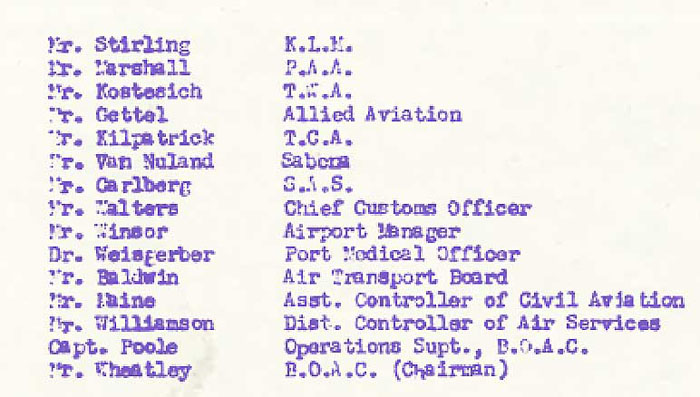
Housing for Pan Am
In a previous meeting, this committee discussed the problems of housing and accommodation, which was limited. Among the points brought up, notably by Pan Am, was the use of transient quarters by permanent personnel, the need for a mail box on the "American side" where Pan Am personnel resided and even safety of streets where schools were located. As shown in the photo below:
º Pan Am personnel occupied two buildings, namely 17 and 18 Chestnut.
º Two other buildings, 69 and 70 Roosevelt, housed American Overseas Airlines which became part of Pan Am in September 1950, Ground Controlled Approach (provided by Pan Am) as well as Allied Aviation, a ground maintenance based largely on Pan Am personnel.
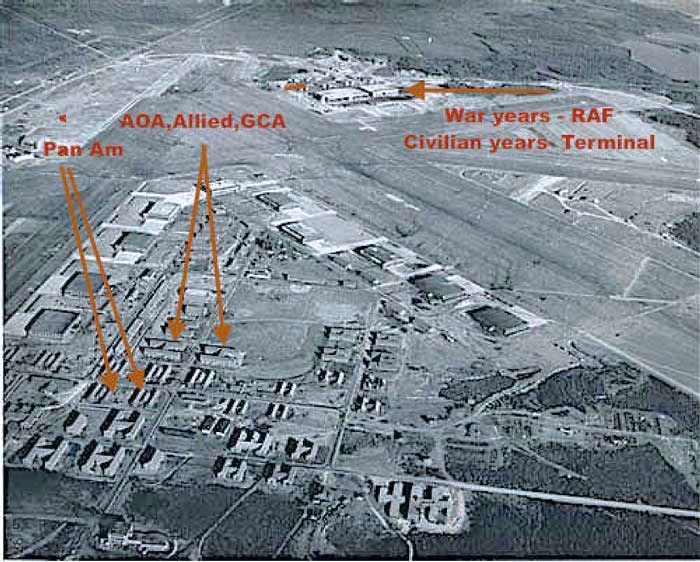 Aerial View of Gander
Aerial View of Gander
First Scheduled Flights
American Export Airlines was the first airline to offer regularly scheduled landplane commercial flights across the North Atlantic. Using DC-4 aircraft, it began passenger services from New York to England via Gander, on 24 October 1945. Pan Am started its own flights through Gander very shortly thereafter, also using DC-4s. By the start of the new year, it had scheduled five DC-4s per week from to London via Gander and two more to Lisbon via Gander and the Azores. A typical DC-4 flight New York-London with a stop in Gander was about 17 1/2 hours.
 Pan Am DC-4 at Gander
Pan Am DC-4 at Gander
Upgrading Pan Am's Aircraft: 1940s Constellations & Stratocruisers
Pan Am soon upgraded its fleet of aircraft. It had ordered twenty Lockheed 049 Constellations and ten longer-range versions in June 1940 which were of course requisitioned by the military. The first of these was finally delivered on 5 January 1946 with a second one a week later, enabling Pan American to open North Atlantic Constellation service through Gander on 14 January 1946, beating TWA who did not start until 5 February.
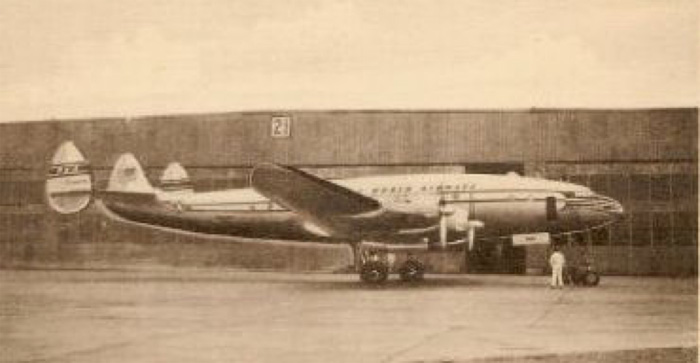 Pan Am Constellation, Hangar 21, Gander, 1950
Pan Am Constellation, Hangar 21, Gander, 1950
Another important Pan Am aircraft was the 377 Stratocruiser, based on the B-29 bomber that dropped the atomic bomb on Hiroshima. Pan Am ordered twenty in November 1945 and started them through Gander in 1949. A “Super” Stratocruiser was deployed on the airline’s most prestigious route, the New York-London flight 100/101, until replaced by the Boeing 707.
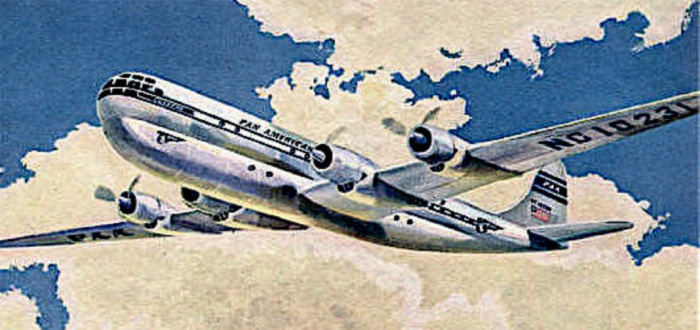 Pan Am Stratocruiser postcard
Pan Am Stratocruiser postcard
Pan Am 1950s Aircraft in Gander: DC-6Bs & DC-7s
In September 1950 Pan Am ordered 45 Douglas DC-6Bs. The first Atlantic flight inaugurated the Pan Am "all-tourist class" service between New York and London via Gander on 01 May 1950, as opposed to the Stratocruiser which tended toward the higher paying passengers. The DC-6 was essentially a stretched out DC-4.
These DC-6Bs were followed by the DC-7 series, 40 inches longer. Pan Am's DC-7Bs started flying transatlantic in summer 1955, getting from New York to London 1 hr 45 min faster than the Super Stratocruiser. The DC-7B could quite often fly the Atlantic New York - London non stop. By summer 1956. Pan Am's DC-7Cs finally started doing it fairly consistently. Unless there was a very strong headwind on the way back to North America, these "Seven Seas" were less commonly seen in Gander.
Over and above the type of aircraft used, by the end of 1945 one could see that things were becoming permanent on the ground. As seen below, personnel headed to Nfld were told to check their passports:
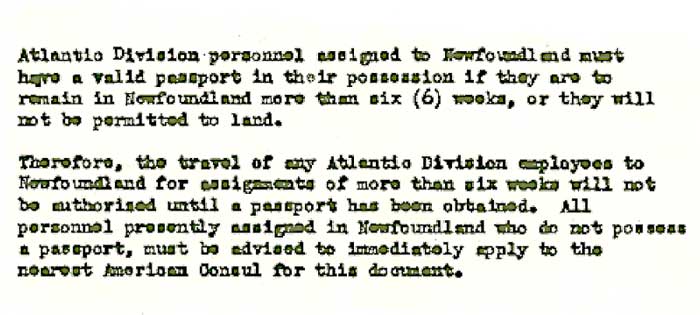 Memo 05 December ‘45 from the Industrial Relations Dept.
Memo 05 December ‘45 from the Industrial Relations Dept.
The Story of Gander’s Landing Rights & Fees
Pan Am operations in Gander, initially under Frank Sylvester, proceeded roundly after the war, being governed by the normal play of international competition and technical progress. There were however, a couple of situations which were a thorn in their side.
One of these was the cost of landing rights, notably as Pan Am in 1946 wondered why they had to pay Nfld when in fact the airport, to their mind, was still under the control of the Canadians, as can be seen in the memo below of 13 December. 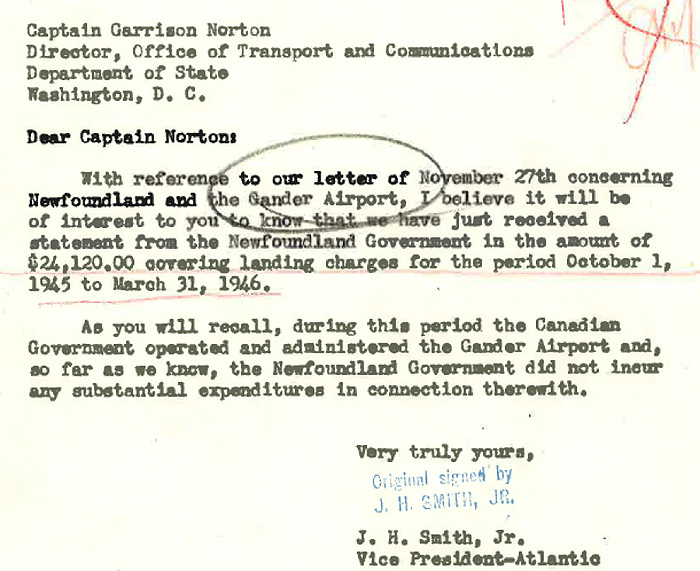
There was movement toward making a request to the International Air Transport Association (IATA) for some sort of mediation effort, especially as AOA and TWA had not yet paid their landing fees. Still Pan Am headquarters decided to continue in good faith with talks with Canada. However, by mid-February 1950, the problem had not yet been fixed and Pan Am hired legal counsel, Aldous Aylan of Aylan and McLaren of Ottawa, to represent them. A letter from Pan Am to their law office referred to a meeting with them and Air Vice Marshall Cowlay, (just before Nfld joined Canada in 1949.) #10
The landing fees in Gander were in fact quite high compared to elsewhere. It is not known who decided the fee level, but probably not by local authorities. My suspicion is that that the Nfld government, not being rich after the war effort, hoped to profit from the airport's "monopoly" position with respect to Gander's geographical position. This table covers 1949 landing fees:#11
But in 1950, Gander's fees didn't go down - other eastern Canadian airport fees went up!
The following shows Pan Am flights in the Maritimes in that period:

Available sources do not indicate how the landing fee business ended up. There were also other money-related questions, especially in the late 50s, about telecommunication costs, building leases and labour relations costs. At least some of this ended up in court, perhaps giving rise to the intriguing memo below!
Go to Pan Am Ops in Gander Part 2 - 1940s & 1950s

